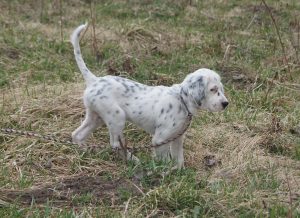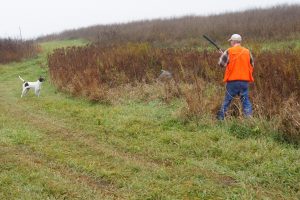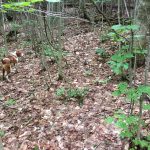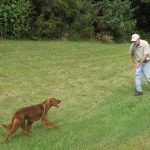Pointing Dog Pointer: The Eye of the Tiger
First Season Series
By Bob and Jody Iler
For us, the most exciting and rewarding part of gun dog training is to watch that pup that didn’t know anything turn into one that has the “eye of the tiger” as he grows into a superb pointing dog! As your pup’s first hunting season rolls around, let’s talk about what you can do to help your dog develop that gleam in his eye or, if it’s already there, make it even more intense!
Pups from top-notch bloodlines are often born with the eye of the tiger. When introduced to birds in the proper manner, it’s as though they’ve been set on fire. They become eager, single-minded, and enthusiastic bird finders. When they are out in the field, they are focused only on birds. They will hunt with joy and desire, oblivious of everything else—including bad weather, difficult cover, and even you!
To keep the eye of the tiger at full intensity, it’s absolutely crucial that—first and foremost—your young pointing dog finds birds in his first season. You don’t want to take him out to a place where he’ll hunt his heart out and not find a single bird.
Wild birds, of course, are best, but a lot of us don’t have access to nearby places each weekend where we can be fairly certain our young dog will readily find birds. If you have hunting spots where you are sure your pup will find birds, that’s great. But taking a young dog to a place like the Dakotas, where there will be multitudes of birds (and hunters), is not the best scenario in your pup’s first season.
Game preserves are great places to get your pup into birds and do things on your own terms, upping the ante so that your dog will have fun and find birds, and learn to work solely with you. You can choose the type of bird you want to use; you can “plant” the birds to make it easier for pup to find them; and you can have the privacy you need in order to have positive hunting sessions with your dog.
At game preserves, you can start out with the gamey little quail that will soon have your dog excited almost to bursting. You can move on to chukars, which will sit tighter and fly well. Finally, you can progress to pheasants when pup is ready. Each of these birds will teach your pup new lessons as he progresses, and always, will keep him finding birds, having a good time, and wanting more as he develops the eye of the tiger!
Another important consideration is where and when you hunt. You don’t want to start out with tough-to-negotiate grounds, or hunt your pup in poor weather that makes it harder for him to find birds. Cover that is too dense or high, weather that is too dry and hot, or snow that is too deep are all deterrents to hunting for young, inexperienced dogs. You want to hunt him in good weather conditions and in easy to cover terrain, with plenty of birdy objectives. If things get too tough, the young dog may soon quit hunting, and a negative experience is not what you want him to remember on the ride home.
Let’s take a look at the issues of handling, pointing, and gun work in this first season, too.
You’ll want to hunt that pup alone at first so he can shine on his own, finding birds and learning what it’s all about. Don’t assume that an older dog will teach him the ropes. This is pup’s time to learn the ropes himself. As the season progresses, hunting your pup with another young dog that is at the same level of experience should be all right, as long as the dogs get along.
If your pup was solidly pointing as he enters the first season, that should intensify as he develops over time. If he wasn’t pointing, he’ll likely start—especially when hunted on wild birds. Either way, don’t make this a big issue right now. Remember the eye of the tiger? First, we want that pup bird-crazy! All the rest will come with time, training, and patience. But not if he doesn’t first want to be out there hunting for birds with zest and abandon.
When it comes to handling in the field in this first season, it’s also okay to be a little lenient here as well. More great dogs are ruined by too much control and pressure early on when they should still be regarded as youngsters finding their way. You can’t pull a dog in later if you don’t give him his head now and let him get out there and hunt for the birds!
It should go without saying that your young dog should be developed to the gun before taking him out hunting or to the game preserve in the first season. Even then, you want to be careful and shoot just once or twice at a bird after each flush, and shooting just a few birds per hunting session is better at this stage. Take care to make sure that your pup is working the bird, has pointed it, and seen it flush before you shoot. Shots coming out of nowhere, not associated with a bird, can dampen a pup’s enthusiasm or worse yet, cause him to become cautious or maybe even quit hunting. We’ve seen this happen with young dogs on occasion.
Remember everything you do with your dog in this first season should be positive, fun and rewarding for the pup. You want him to be trembling with excitement each time you take him out. You want him to almost “shoot out into the field like a cannon” with enthusiasm and drive. You want him to pay no attention to the sound of the gun, only be intent on the bird. You’ll want to make things easy on him at the start of this, his hunting career, by choosing the best cover, the best birds, and the best weather for a good hunt. You’ll want to go easy on his mistakes and not reign him in or over-control him.
In short, your goal will be to develop and foster the eye of the tiger in your pointing dog! It’s up to you to do everything you can to ensure your pup’s success in his first season!
Pointing Dog Pointers features monthly training tips by Bob and Jody Iler, who own Green Valley Kennels in Dubuque, Iowa. Bob and Jody have trained pointing dogs for over 35 years and have written many articles for The Pointing Dog Journal.







